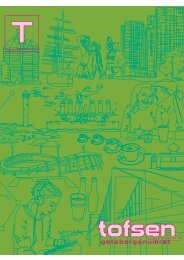Saker vi minns från - Tofsen
Saker vi minns från - Tofsen
Saker vi minns från - Tofsen
Create successful ePaper yourself
Turn your PDF publications into a flip-book with our unique Google optimized e-Paper software.
tHEENGINEER<br />
The fuTure of<br />
ENGINEERING EducatIoN<br />
Author: MikAEl EnElund<br />
photogrAphEr: EMil johAnsson<br />
The mission of an engineer is to create and develop products<br />
and systems that improve safety and quality of life for<br />
a growing population. This mission must be achieved using<br />
a minimum amount of resources in order to ensure that<br />
we do not compromise quality of life and safety for future<br />
generations. The challenges that we will face during the next<br />
decades are huge. For example, we will need new technologies,<br />
systems and solutions for energy supply and transportation.<br />
Furthermore, due to the growing global population,<br />
utilization of materials, land and other resources must<br />
be more efficient. Engineers need to take active and leading<br />
roles in sol<strong>vi</strong>ng these challenges such that we achieve a sustainable<br />
society. This needs to be achieved during the careers<br />
of today's students!<br />
One major concern is that young people today are less interested<br />
in engineering education and an engineering career.<br />
In Sweden, the demographic situation is such that the number<br />
of twenty year olds will decrease during the next ten<br />
years. At the same time, many people will be retiring from<br />
the workforce. In order to meet the need for new engineers<br />
during these adverse conditions, engineering education<br />
must create exciting and attractive opportunities for a diverse<br />
pool of talented<br />
young people<br />
If you get “killed,” you just<br />
try something else until<br />
you get to the next level.<br />
from all areas of<br />
our society.<br />
The rapid development<br />
of computers<br />
and the<br />
internet has given new opportunities for engineering work.<br />
Most problem solutions and developments incorporate high<br />
precision digital models. Engineers are able to solve very<br />
complex problems using modern computer tools. However,<br />
this has not been fully implemented into current engineering<br />
education programs. Students spend too much time sol<strong>vi</strong>ng<br />
oversimplified problems that can be expressed analytically<br />
and with solutions that are already known in advance. Instead,<br />
we should be using computers to solve more general,<br />
real-world problems. The ability to effectively use such tools<br />
during one's engineering career is also a key component of<br />
the globalization of engineering. It is easy to transfer digital<br />
models and global companies are employing engineers in<br />
low cost countries for such tasks as design, development and<br />
research. Our engineering education must prepare students<br />
for working in a global market. Engineers educated at Chalmers<br />
must be able to compete and pro<strong>vi</strong>de added value that<br />
can't easily be sourced from low-wage markets.<br />
Furthermore, young people learn much differently than<br />
they used to just a few decades ago. Researchers in the area<br />
of pedagogy refer to this as the “Nintendo Syndrome”. The<br />
<strong>vi</strong>deo-games generation does not read manuals. Instead,<br />
they jump right in and give it a try. If you get “killed,” you<br />
just try something else until you get to the next level. If<br />
that doesn’t work, just go to the internet to get a hint. From<br />
my observations of children, I have noticed that this way of<br />
learning is very efficient. I have also noticed that this attitude<br />
seems to prevail when it comes to studying. Con<strong>vi</strong>ncing<br />
students to read a book has become increasingly difficult.<br />
But, students do find it educationally rewarding to actually<br />
try something before reading about it. Furthermore, the<br />
vast majority of students own a laptop and a smart-phone<br />
equipped with processors, accelerometers and gyroscopes.<br />
So, they are easily able to conduct both simulations and testing.<br />
We need to develop teaching and the infrastructure to<br />
take advantage of this.<br />
The engineering education must prepare students for the<br />
challenges mentioned above and it must be continuously<br />
developed in order to meet these needs. For the Chalmers<br />
Mechanical Engineering program, we have a long-term<br />
project underway for just this purpose, which is called<br />
Shaping the Future of Mechanical Engineering. Students,<br />
professors, industry and administration are involved in<br />
the project. The aim is to fully develop all the skills of our<br />
students and their full potential such that they become the<br />
new renaissance engineers who are well prepared to take on<br />
these challenges!<br />
31













